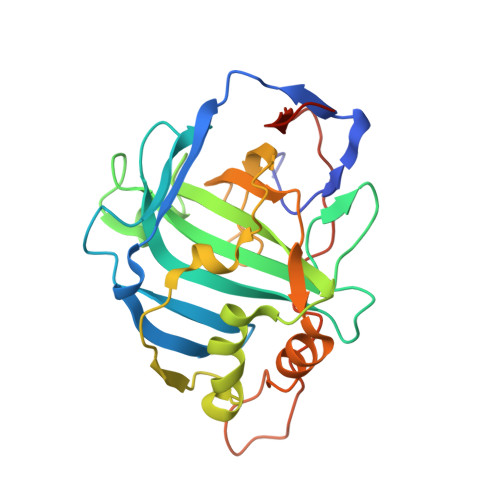Crystal structure of F65A/Y131C-methylimidazole carbonic anhydrase V reveals architectural features of an engineered proton shuttle.
Jude, K.M., Wright, S.K., Tu, C., Silverman, D.N., Viola, R.E., Christianson, D.W.(2002) Biochemistry 41: 2485-2491
- PubMed: 11851394
- DOI: https://doi.org/10.1021/bi015808q
- Primary Citation of Related Structures:
1KEQ - PubMed Abstract:
The crystal structure of F65A/Y131C murine alpha-carbonic anhydrase V (CAV), covalently modified at cysteine residues with 4-chloromethylimidazole, is reported at 1.88 A resolution. This modification introduces a methylimidazole (MI) group at residue C131 in the active site with important consequences. F65A/Y131C-MI CAV exhibits an up to 3-fold enhancement of catalytic activity over that of wild-type CAV [Earnhardt, J. N., Wright, S. K., Qian, M., Tu, C., Laipis, P. J., Viola, R. E., and Silverman, D. N. (1999) Arch. Biochem. Biophys. 361, 264-270]. In this modified CAV variant, C131-MI acts as a proton shuttle, facilitating the deprotonation of a zinc-bound water molecule to regenerate the nucleophilic zinc-bound hydroxide ion. A network of three hydrogen-bonded water molecules, across which proton transfer likely proceeds, bridges the zinc-bound water molecule and the C131-MI imidazole group. The structure of F65A/Y131C-MI CAV is compared to structures of Y64H/F65A murine CAV, wild-type human alpha-carbonic anhydrase II, and the gamma-carbonic anhydrase from Methanosarcina thermophilain an effort to outline common features of catalytic proton shuttles.
- Roy and Diana Vagelos Laboratories, Department of Chemistry, University of Pennsylvania, Philadelphia, Pennsylvania 19104-6323, USA.
Organizational Affiliation:




















